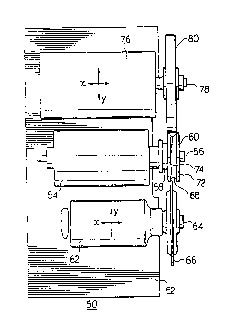Some of the information on this Web page has been provided by external sources. The Government of Canada is not responsible for the accuracy, reliability or currency of the information supplied by external sources. Users wishing to rely upon this information should consult directly with the source of the information. Content provided by external sources is not subject to official languages, privacy and accessibility requirements.
Any discrepancies in the text and image of the Claims and Abstract are due to differing posting times. Text of the Claims and Abstract are posted:
| (12) Patent: | (11) CA 2271584 |
|---|---|
| (54) English Title: | MULTI TASK GRINDING WHEEL MACHINE |
| (54) French Title: | MEULE A DOUBLE FONCTION |
| Status: | Expired and beyond the Period of Reversal |
| (51) International Patent Classification (IPC): |
|
|---|---|
| (72) Inventors : |
|
| (73) Owners : |
|
| (71) Applicants : |
|
| (74) Agent: | EDWARD H. OLDHAMOLDHAM, EDWARD H. |
| (74) Associate agent: | |
| (45) Issued: | 2003-09-09 |
| (22) Filed Date: | 1999-05-12 |
| (41) Open to Public Inspection: | 2000-11-12 |
| Examination requested: | 1999-05-12 |
| Availability of licence: | N/A |
| Dedicated to the Public: | N/A |
| (25) Language of filing: | English |
| Patent Cooperation Treaty (PCT): | No |
|---|
| (30) Application Priority Data: | None |
|---|
This application describes a grinder for grinding a workpiece situated so as to be accessible to two separate grinding wheels simultaneously. A grinding operation may be carried out on a workpiece to simultaneously grind different profiles on the workpiece without removal from the workpiece spindle.
Cette application décrit une meule destinée à moudre une pièce placée de manière à être accessible simultanément à deux meules distinctes. Une opération de meulage peut être effectuée sur une pièce pour moudre simultanément différents profils sur la pièce sans nécessiter le retrait de l'axe de la pièce.
Note: Claims are shown in the official language in which they were submitted.
Note: Descriptions are shown in the official language in which they were submitted.

2024-08-01:As part of the Next Generation Patents (NGP) transition, the Canadian Patents Database (CPD) now contains a more detailed Event History, which replicates the Event Log of our new back-office solution.
Please note that "Inactive:" events refers to events no longer in use in our new back-office solution.
For a clearer understanding of the status of the application/patent presented on this page, the site Disclaimer , as well as the definitions for Patent , Event History , Maintenance Fee and Payment History should be consulted.
| Description | Date |
|---|---|
| Time Limit for Reversal Expired | 2018-05-14 |
| Letter Sent | 2017-05-12 |
| Inactive: Office letter | 2012-06-19 |
| Inactive: Late MF processed | 2012-06-05 |
| Inactive: Payment - Insufficient fee | 2012-05-24 |
| Letter Sent | 2012-05-14 |
| Small Entity Declaration Determined Compliant | 2008-04-17 |
| Inactive: IPC from MCD | 2006-03-12 |
| Inactive: IPC from MCD | 2006-03-12 |
| Inactive: IPC from MCD | 2006-03-12 |
| Inactive: IPC from MCD | 2006-03-12 |
| Inactive: IPC from MCD | 2006-03-12 |
| Grant by Issuance | 2003-09-09 |
| Inactive: Cover page published | 2003-09-08 |
| Pre-grant | 2003-06-10 |
| Inactive: Final fee received | 2003-06-10 |
| Notice of Allowance is Issued | 2003-06-04 |
| Letter Sent | 2003-06-04 |
| Notice of Allowance is Issued | 2003-06-04 |
| Inactive: Approved for allowance (AFA) | 2003-05-23 |
| Amendment Received - Voluntary Amendment | 2003-04-14 |
| Inactive: S.30(2) Rules - Examiner requisition | 2003-04-01 |
| Inactive: Delete abandonment | 2003-02-18 |
| Inactive: Adhoc Request Documented | 2003-02-18 |
| Inactive: Abandoned - No reply to s.30(2) Rules requisition | 2002-12-02 |
| Amendment Received - Voluntary Amendment | 2002-11-29 |
| Inactive: S.30(2) Rules - Examiner requisition | 2002-05-31 |
| Inactive: Office letter | 2000-12-19 |
| Inactive: Correspondence - Prosecution | 2000-12-18 |
| Inactive: Adhoc Request Documented | 2000-11-28 |
| Request for Examination Received | 2000-11-28 |
| Application Published (Open to Public Inspection) | 2000-11-12 |
| Inactive: Cover page published | 2000-11-12 |
| Inactive: First IPC assigned | 1999-06-30 |
| Letter Sent | 1999-06-22 |
| Letter Sent | 1999-06-17 |
| Inactive: Filing certificate - No RFE (English) | 1999-06-16 |
| Filing Requirements Determined Compliant | 1999-06-16 |
| Application Received - Regular National | 1999-06-10 |
| Amendment Received - Voluntary Amendment | 1999-05-12 |
| Request for Examination Requirements Determined Compliant | 1999-05-12 |
| All Requirements for Examination Determined Compliant | 1999-05-12 |
| Request for Examination Received | 1999-05-12 |
There is no abandonment history.
The last payment was received on 2003-04-15
Note : If the full payment has not been received on or before the date indicated, a further fee may be required which may be one of the following
Please refer to the CIPO Patent Fees web page to see all current fee amounts.
Note: Records showing the ownership history in alphabetical order.
| Current Owners on Record |
|---|
| MARIO FABRIS |
| Past Owners on Record |
|---|
| None |